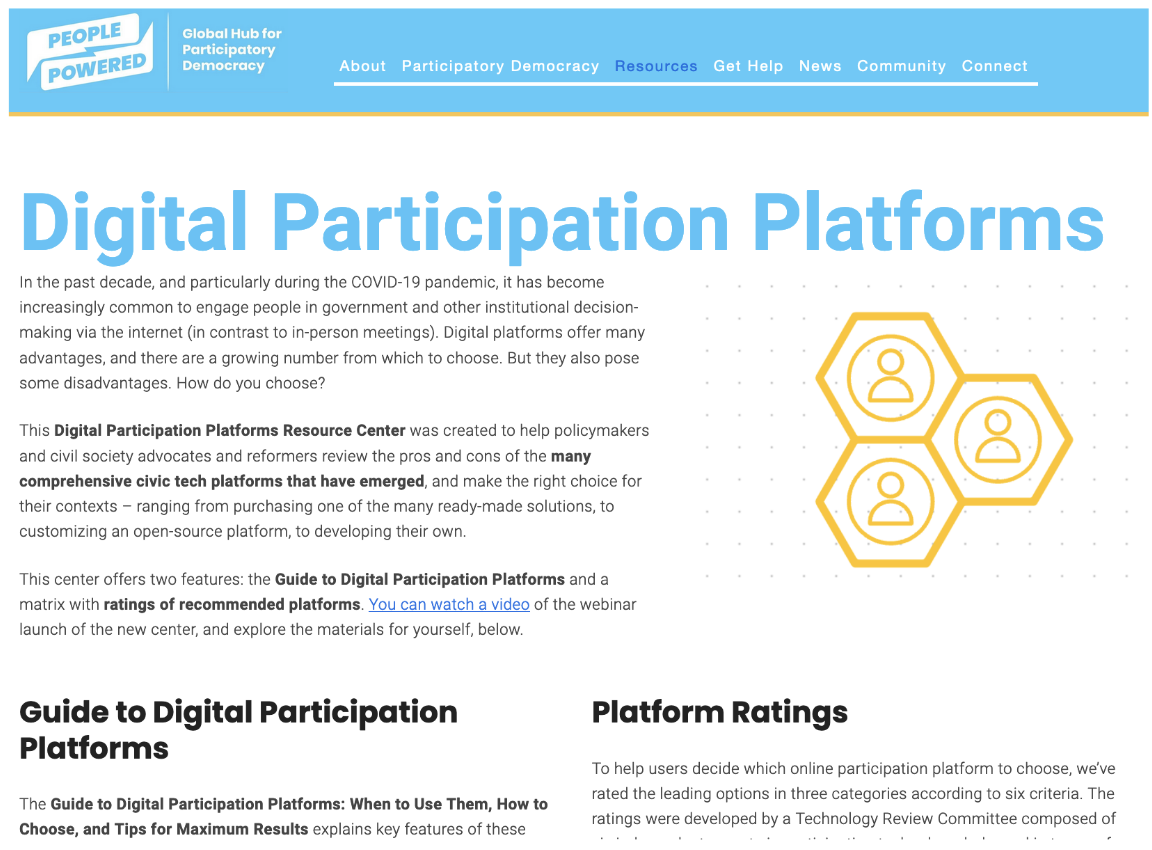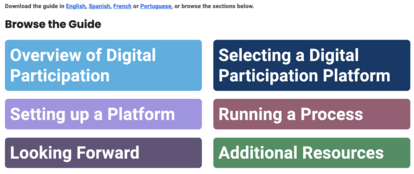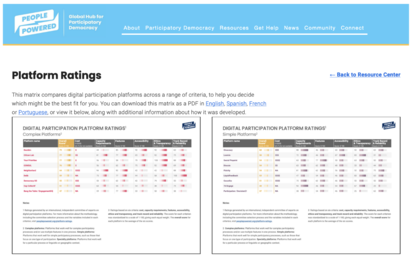Innovation for Democracy Café
Digital Participation Tools: When to use them, how to choose them

The last ten years saw a great increase in digital participation and development of Civic Tech tools. Originally this mode of participation started gaining traction due to the fact that existing political spaces were not open and accessible enough. So, communities started to create online spaces that would allow for a more egalitarian form of engagement. However, it has been then quickly noted that social media does not provide sufficient structure and poses specific challenges caused by, for example, perpetuated echo chambers. Therefore, it became necessary to design tools that would facilitate structured dialogue and data gathering whilst providing maximum security and openness.
Guide to Digital Participation Platforms and Platform Ratings as resources

However, the true global rise of Civic Tech came with the COVID-19 pandemic that pushed governments towards more rapid and intensive cooperation with the members of their community. At the same time, those processes needed to be kept online since in person activities were minimized in order to ensure safety of all. Due to this, many communities realized that the use of Civic Tech is beneficial and essentially inevitable.
Yet since it is an emerging and quickly developing field, up until this point information about the best practices in the industry and functionalities of state-of-the-art tools was limited and highly fragmented. The knowledge about tools and common processes that could benefit from their implementation was hard and costly to attain. Therefore, the majority of local actors continue to see digital participation and Civic Tech as only accessible for a top tier of biggest and richest cities. Even though any town and city can greatly benefit from introducing complementary digital participation mechanisms.
Echoing this need for more accessible resources on digital participation platforms, People Powered’s members from all across the world voted to source and mainstream knowledge about digital participation, and create materials that would allow anyone to swiftly learn the basics and identify ways in which Civic Tech can be useful for them. That is how the idea of the Digital Participation Platforms page that includes the Guide to Digital Participation Platforms: When to Use Them, How to Choose and Tips for Maximum Results came about.
How we keep the process inclusive and diverse

To ensure that the resources on digital participation platforms are relevant to communities of all levels of maturity and resources, People Powered set up an inclusive process that aimed at sourcing knowledge from all its members. The goal was to ensure diversity of locations, socio-economic backgrounds, and roles of the experts. Those members of the larger network - including city officials, experts, practitioners, and academics - provided information about the best practices they know about from their context and suggested the tools for an evaluation. The tools were then reviewed by a gender balanced and regionally diverse group of experts on Civic Tech who ended up ranking 27 of the most widely used and effective digital platforms from across the world. Those platforms were evaluated according to the criteria ranging from cost and technical requirements to supported functionalities and ethics. The ratings therefore provide a quick comparison of the tools and allow for a faster and cheaper implementation of digital participation.
A holistic guide for your digital participation strategy
However, the resources on digital participation platforms provide more than just an overview of tools. The guide offers basic information about what value digital participation has and what the common processes that users can benefit from it are. It also provides guidance on how to select a platform as well as set up and run a process, which helps to effectively advocate for use of Civic Tech and allows a community to prepare for its successful implementation reducing a relatively high barrier of entry for communities that have limited or no experience about digital engagement and Civic Tech. But engaging smaller and less tech-savvy communities is a challenge still.
A lot of communities still believe that digital participation is not suitable for them. Their perception as such may come from their context of low levels of Internet penetration and lack of resources or know-how. Yet these resources help reduce their fear of technology and dissipate some myths about digital participation while also providing practical guidance, and thus makes its implementation a more realistic goal even for communities that normally do not see themselves at the forefront of innovation.
At the same time, the Guide and Ratings help mainstream common concepts in order to ensure that a community of experts and practitioners shares the same language and thus can communicate with each other effectively. The Guide and Ratings are also structured in a way that allows to explain and discuss complex ideas, for example use of Open Source and the costs associated with it. It helps to set more realistic expectations, standards, and goals among the beginners who are just starting to explore a field of digital participation.
A guide that meets the need of the people and governments
Even though the Guide and Ratings tried to capture a great variety of tools and methods for their use, due to limited resources and capacities – including, for example, language limitations of the expert team - it was not possible to cover all the tools and best practices from every region available in every language. Therefore, there is a lot of room for next steps improvement, such as broader assessment of platforms including their direct testing, and expanding ratings to more tools.
Yet the value of these resources is overwhelming. First of all, they serve as a common ground for developing shared understanding of key concepts and thus increasing the depth of international cooperation in this field. They also help to dramatically cut the costs by decreasing the time required for research, providing an overview of pricing range, and uncovering hidden costs. Lastly, they show to others what is possible when it comes to functionalities and digital participation processes and encourages them to adhere to higher standards in data privacy, ethics, and accessibility.
Lastly the Guide and Ratings are designed to show real needs of city officials and their communities. Thus, it provides a wealth of information to Civic Tech companies and experts who work on digital participation on the ways in which they can enhance their tools and methods. After the publication of the Guide and Ratings, People Powered have received messages from some organizations claiming that now they have a better idea on how to improve their tools and bring higher value to governmental institutions and ultimately increase inclusion and quality of participatory processes in given communities.
A reminder to rethink the purpose of civic tech
Nevertheless, potential users should not forget that Civic Tech is not an ultimate solution but a tool. So, organizations should recognize that digital participation is not a panacea but just another type of participation that cannot and should not fully substitute in-person processes. It can serve as a complimentary layer that can help enlarge the number of participants and engage hard to reach or disengaged members of a community. Therefore, each reader of a guide should have a clear understanding of who they want to reach through technology and see how online engagement should be linked with in-person channels in order to achieve maximum effect.
So, when referring to the Guide and Ratings, try to start by asking yourself “What do I need? How can Civic Tech help me?” Those questions can help you stay cool-headed and not get overly excited about a tool that might ultimately not be suitable for your community or a specific goal and process. Otherwise, you risk burning your resources on a tool that would not generate significant engagement. It is then important to come to these resources with an open yet clear mind and a great understanding of what your community needs. This way you will be guaranteed to find a useful and inspirational example and benefit from the wealth of knowledge from all across the world.
And ultimately, do not forget that digital platforms are just instruments that cannot work on their own. They require thorough planning and infrastructure in order to generate engagement. So, in case you see that people do not engage with you and your technology, look closer into the process and see what are the obstacles and limitations that prevent people from being more involved.
This Guide, which can be found in its entirety here, was officially developed with the support of the National Endowment for Democracy, an independent, nonprofit foundation dedicated to the growth and strengthening of democratic institutions around the world, and the International Republican Institute, a nonpartisan, nonprofit organization committed to advancing freedom and democracy worldwide.
Ms Katya Petrikevich is the Co-founder and International Director of Participation Factory and contributor for People Powered’s Guide to Digital Participation Platforms and Platform Ratings.
Register for our Innovation for Democracy Cafe on June 28 to learn more from her and our guests!
